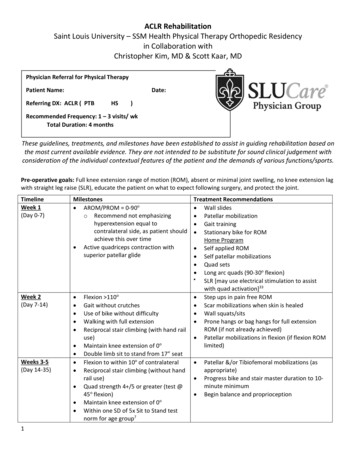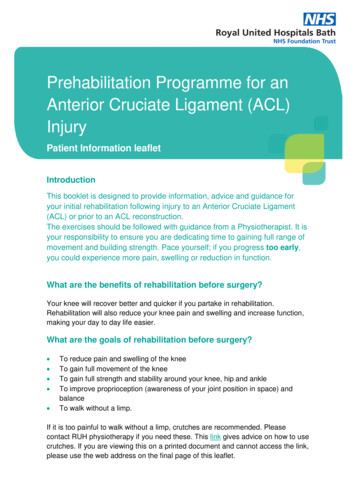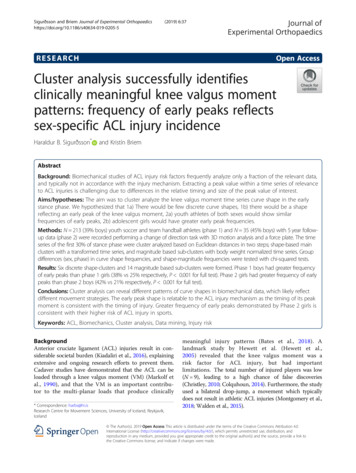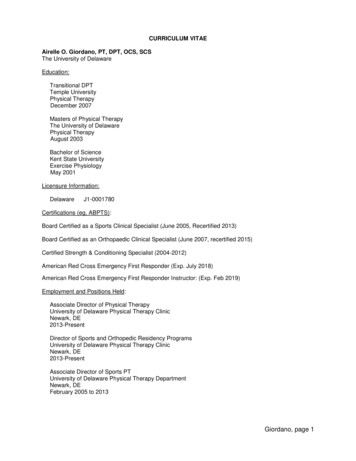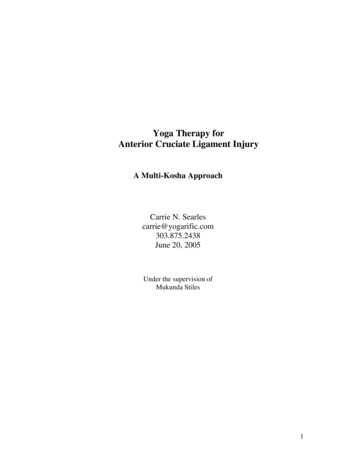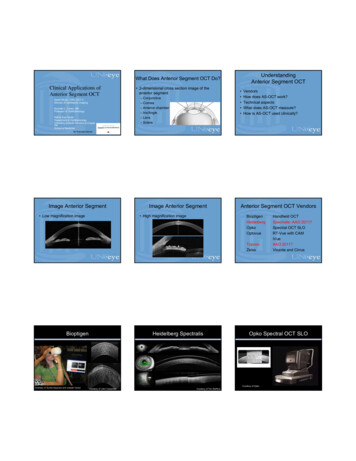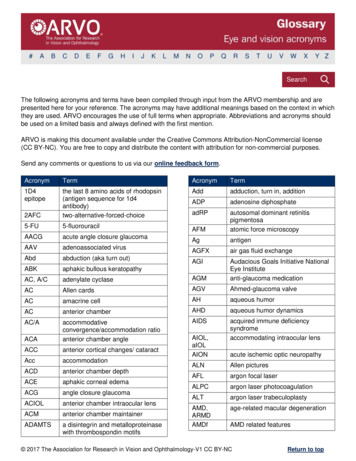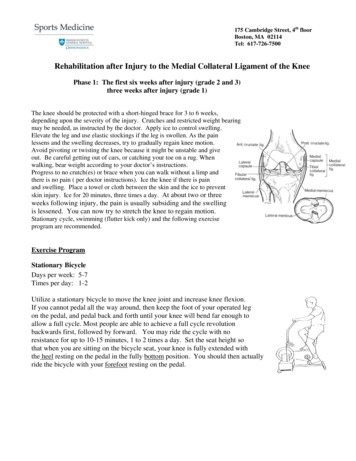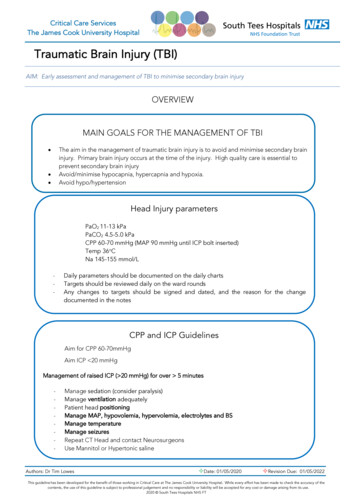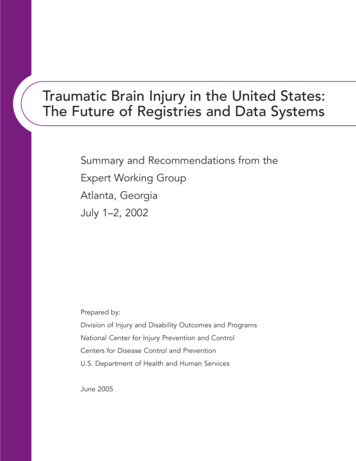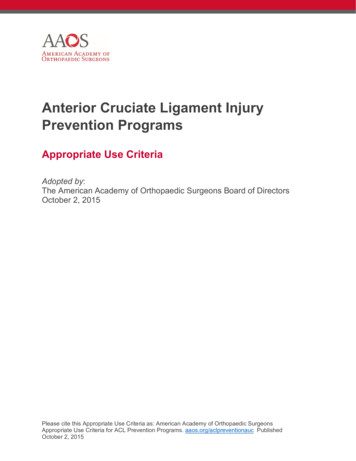
Transcription
Anterior Cruciate Ligament InjuryPrevention ProgramsAppropriate Use CriteriaAdopted by:The American Academy of Orthopaedic Surgeons Board of DirectorsOctober 2, 2015Please cite this Appropriate Use Criteria as: American Academy of Orthopaedic SurgeonsAppropriate Use Criteria for ACL Prevention Programs. aaos.org/aclpreventionauc PublishedOctober 2, 2015
DisclaimerVolunteer physicians from multiple medical specialties created and categorized theseAppropriate Use Criteria. These Appropriate Use Criteria are not intended to be comprehensiveor a fixed protocol, as some patients may require more or less treatment or different means ofdiagnosis. These Appropriate Use Criteria represent patients and situations that clinicianstreating or diagnosing musculoskeletal conditions are most likely to encounter. The clinician’sindependent medical judgment, given the individual patient’s clinical circumstances, shouldalways determine patient care and treatment.Disclosure RequirementIn accordance with American Academy of Orthopaedic Surgeons policy, all individuals whosenames appear as authors or contributors to this document filed a disclosure statement as part ofthe submission process. All authors provided full disclosure of potential conflicts of interest priorto participation in the development of these Appropriate Use Criteria. Disclosure information forall panel members can be found in Appendix B.Funding SourceThe American Academy of Orthopaedic Surgeons exclusively funded development of theseAppropriate Use Criteria. The American Academy of Orthopaedic Surgeons received no fundingfrom outside commercial sources to support the development of these Appropriate Use Criteria.FDA ClearanceSome drugs or medical devices referenced or described in this document may not have beencleared by the Food and Drug Administration (FDA) or may have been cleared for a specific useonly. The FDA has stated that it is the responsibility of the physician to determine the FDAclearance status of each drug or device he or she wishes to use in clinical practice.CopyrightAll rights reserved. Reproduction, storage in a retrieval system, or transmission, in any form, orby any means, electronic, mechanical, photocopying, recording, or otherwise, of any part of thisdocument, requires prior written permission from the American Academy of OrthopaedicSurgeons.Published 2015 by the American Academy of Orthopaedic Surgeons9400 West Higgins RoadRosemont, IL 60018First EditionCopyright 2015 by the American Academy of Orthopaedic Surgeons
For a more user-friendly version of this AUC, or to view additionalAUCs, please visit the AAOS AUC web-based app at:www.OrthoGuidelines.org/auc
Table of ContentsWriting Panel . iVoting Panel. iVoting Panel Round Two Discussion Moderators. iAUC Section Leader, AAOS Committee on Evidence-Based Quality and Value . iiChair, AAOS Committee on Evidence-Based Quality and Value . iiChair, AAOS Council on Research and Quality. iiAAOS Staff . iiI.INTRODUCTION .1Overview . 1Conditions Not Covered by this AUC . 2II.METHODS .3Developing Criteria . 3Formulating Indications and Scenarios . 4Creating Definitions and Assumptions . 5Literature Review. 6Determining Appropriateness . 6Voting Panel. 6Rating Appropriateness/Helpfulness . 6Round One Voting . 7Round Two Voting . 8Final Ratings . 8Revision Plans. 9Disseminating Appropriate Use Criteria . 9III. PATIENT INDICATIONS AND TREATMENTS .10Indications . 10Treatments. 11IV. RESULTS OF APPROPRIATENESS RATINGS .12Appropriate Use Criteria for Treatment of Anterior Cruciate Ligament Injuries . 16Appendices . 20Appendix A. Documentation of Approval . 21Appendix B. Disclosure Information . 22Appendix C. References . 26
WRITING PANELRobert Marx, MD, MSc, FRCSCAmerican Orthopaedic Society for SportsMedicineRick Wright, MDAmerican Orthopaedic Society for SportsMedicineJeffrey P. Feden, MD, FACEPAmerican College of Emergency PhysiciansRobert A. Magnussen MD, MPHInternational Society of Arthroscopy, KneeSurgery and Orthopaedic Sports MedicineDavid Anthony Parker MBBS, BMedSci,FRACSInternational Society of Arthroscopy, KneeSurgery and Orthopaedic Sports MedicineBrian Pietrosimone PhD, ATCNational Academy of Sports MedicineElvire Servien MD, PhD, ProfInternational Society of Arthroscopy, KneeSurgery and Orthopaedic Sports MedicineAnthony Beutler, MDAmerican Medical Society for Sports MedicinePeter H. Seidenberg, MD, FAAFP, FACSMAmerican College of Sports MedicineDaniel C. Herman, MD, PhD, CAQSMAmerican Academy of Physical Medicine andRehabilitationMichael Khazzam, MDAmerican Academy of Orthopaedic SuregonsChristopher C. Kaeding MDInternational Society of Arthroscopy, KneeSurgery and Orthopaedic Sports MedicineWilliam G. DeLong Jr., MDAmerican College of SurgeonsVOTING PANELSandra J. Shultz, PhDNational Athletic Trainers’ AssociationKevin R. Vincent, MD, PhDAmerican Academy of Physical Medicine andRehabilitationT David Hayes, MDThe Knee SocietyDouglas W. Lundy, MDAmerican College of SurgeonsAnna L. Waterbrook, MD, FACEPAmerican College of Emergency PhysiciansBradley J. Nelson, MDAmerican Orthopaedic Society for Sports MedicineSteven B. Singleton, MDArthroscopy Association of North AmericaNeeru Jayanthi, MDAmerican Medical Society for Sports MedicineCynthia R. LaBella, MDAmerican Medical Society for Sports MedicineMoira Davenport, MDAmerican College of Emergency PhysiciansVOTING PANEL ROUND TWO DISCUSSION MODERATORSi
James O. Sanders, MDGregory A. Brown, MD, PhDAUC SECTION LEADER, AAOS COMMITTEE ON EVIDENCE-BASED QUALITY ANDVALUERobert H. Quinn, MDCHAIR, AAOS COMMITTEE ON EVIDENCE-BASED QUALITY AND VALUEDavid S. Jevsevar, MD, MBACHAIR, AAOS COUNCIL ON RESEARCH AND QUALITYKevin J. Bozic, MD, MBAAAOS STAFFWilliam O. Shaffer, MDMedical DirectorDeborah S. Cummins, PhDDirector, Department of Research and Scientific AffairsJayson Murray, MAManager, Evidence-Based Medicine UnitRyan Pezold, MAResearch Analyst, Evidence-Based Medicine UnitPeter Shores, MPHStatistician, Evidence-Based MedicineKaitlyn SevarinoEvidence-Based Quality and Value (EBQV) CoordinatorErica LinskeyAdministrative Assistant, Evidence-Based Medicine Unitii
I. INTRODUCTIONOVERVIEWThe American Academy of Orthopaedic Surgeons (AAOS) has developed this Appropriate UseCriteria (AUC) to determine the appropriateness/helpfulness of using a supervised AnteriorCruciate Ligament (ACL) injury prevention program to prevent ACL injuries in individuals whoare involved in competitive and/or recreational athletics, have no prior history of ACLreconstruction, and no current history of ACL deficiency. An “appropriate/helpful” healthcareservice is one for which the expected health benefits exceed the expected negative consequencesby a sufficiently wide margin.2 Evidence-based information, in conjunction with the clinicalexpertise of physicians from multiple medical specialties, was used to develop the criteria inorder to improve preventative care and obtain the best outcomes while considering the subtletiesand distinctions necessary in making clinical decisions. The foundation for this AUC is the 2014Management of Anterior Cruciate Ligament Injuries Clinical Practice Guideline, which can beaccessed via the following idelineFINAL.pdfThe purpose of this AUC is to help determine the appropriateness/helpfulness of using asupervised ACL injury prevention program to prevent ACL injuries in individuals who areinvolved in competitive and/or recreational athletics, have no prior history of ACLreconstruction, and no current history of ACL deficiency. The best available scientific evidenceis synthesized with collective expert opinion on topics where gold standard randomized clinicaltrials are not available or are inadequately detailed for identifying distinct patient types. Whenthere is evidence corroborated by consensus that expected benefits substantially outweighpotential risks, exclusive of cost, a procedure is determined to be appropriate. The AAOS usesthe RAND/UCLA Appropriateness Method (RAM).2 Our process includes these steps: reviewingthe results of the evidence analysis, compiling a list of clinical vignettes, and having an expertpanel comprised of representatives from multiple medical specialties determine theappropriateness/helpfulness of each of the clinical indications for treatment. To access anintuitive and more user-friendly version of the appropriate use criteria for this topic online,please visit the AAOS OrthoGuidelines website at www.orthoguidelines.org/auc.These criteria should not be construed as including all indications or excluding indicationsreasonably directed to obtaining the same results. The criteria intend to address the mostcommon clinical scenarios facing all appropriately trained clinicians managing patients underconsideration for preventing anterior cruciate ligament injuries. The ultimate judgment regardingany specific criteria should address all circumstances presented by the patient and the needs andresources particular to the locality or institution. It is also important to state that these criteriawere developed as guidelines and are not meant to supersede clinician expertise and experienceor patient preference.INTERPRETING THE APPROPRIATENESS RATINGSTo prevent misuse of these criteria, it is extremely important that the user of this documentunderstands how to interpret the appropriateness ratings. The appropriateness rating scale rangesfrom one to nine and there are three main range categories that determine how the median ratingis defined (i.e. 1-3 “Rarely Helpful for Preventing an ACL Injury”, 4-6 “May Be Helpful for1AAOS Evidence-Based Medicine UnitAAOS AUC Web-Based Application: www.orthoguidelines.org/auc
Preventing an ACL Injury”, and 7-9 “Likely Helpful for Preventing an ACL Injury”). Beforethese appropriate use criteria are consulted, the user should read through and understand allcontents of this document.ASSUMPTIONS OF THE WRITING PANELBefore these criteria are consulted, it is assumed that:1. Individual is involved in competitive and/or recreational athletics2. No prior history of ACL reconstruction3. No current history of ACL deficiencyCONDITIONS NOT COVERED BY THIS AUC Tibial eminence fracture Collateral ligament injuries Re-tears of prior reconstructions Partial ACL injuriesPATIENT POPULATION & SCOPE OF GUIDELINEThis document is intended for use for both skeletally immature and skeletally mature patientswho have been diagnosed with an ACL injury of the knee.BURDEN OF DISEASEPersons who suffer ACL injuries are at increased risk for developing arthritis later in life.3Females are two to eight times more likely to suffer an ACL injury compared to males.3ETIOLOGYACL rupture is typically the result of a traumatic, sports-related injury. This injury may becontact or non-contact.INCIDENCE AND PREVALENCEThe annual rate of patients who present with anterior cruciate ligament injuries has beenestimated at 252,000.3POTENTIAL BENEFITS, HARMS, AND CONTRAINDICATIONSMost treatments are associated with some known risks, especially invasive and operativetreatments. Contraindications vary widely based on the treatment administered. A particularconcern when treating ACL injuries is routine surgical complications such as infection, DVT,anesthesia complications, etc. Other complications associated with ACL surgery include:postoperative loss of motion or arthrofibrosis, ongoing instability episodes, neurovascular injury,etc. Additional factors may affect the physician’s choice of treatment including but not limited toassociated injuries the patient may present with as well as the individual’s co-morbidities,skeletal maturity, and/or specific patient characteristics including obesity, activities, workdemands, etc. Clinician input based on experience increases the probability of identifying2AAOS Evidence-Based Medicine UnitAAOS AUC Web-Based Application: www.orthoguidelines.org/auc
patients who will benefit from specific treatment options. The individual patient and the patient’sfamily dynamic will also influence treatment decisions therefore, discussion of availabletreatments and procedures applicable to the individual patient rely on mutual communicationbetween the patient and the patient’s guardian (when appropriate for minor patients) andphysician, weighing the potential risks and benefits for that patient. Once the patient andpatient’s guardian has been informed of available therapies and has discussed these options withthe patient and guardian (if appropriate), an informed decision can be made.II. METHODSThis AUC for Anterior Cruciate Ligament Injury Prevention Programs is based on a review ofthe available literature and a list of clinical scenarios (i.e. criteria) constructed and voted on byexperts in orthopaedic surgery and other relevant medical fields. This section describes themethods adapted from the RAND/UCLA Appropriateness Method (RAM)2. This section alsoincludes the activities and compositions of the various panels that developed, defined, reviewed,and voted on the criteria.Two panels participated in the development of the AAOS AUC for Anterior Cruciate LigamentInjury Prevention Programs (see list on page i). Members of the writing panel developed a list of48 patient scenarios, for which the appropriateness/helpfulness of a supervised rehabilitationprogram was evaluated. The voting panel participated in two rounds of voting. During the firstround of voting, the voting panel was given approximately one month to independently rate theappropriateness/helpfulness of a supervised rehabilitation program for each of the relevantpatient scenarios via an electronic ballot. After the first round of appropriateness ratings weresubmitted, AAOS staff calculated the median ratings for each patient scenario. An in-personvoting panel meeting was held in Rosemont, IL on April 25th of 2015. During this meeting,voting panel members addressed the scenarios which resulted in disagreement (definition ofdisagreement can be found in Table 3). The voting panel members were asked to rerate their firstround ratings during the voting panel meeting, only if they were persuaded to do so by thediscussion and available evidence. The voting panel determined appropriateness by ratingsupervised rehabilitation program as ‘Likely Helpful for Preventing an ACL Injury for PatientProfile of Interest’, ‘May Be Helpful for Preventing an ACL Injury for Patient Profile ofInterest’, or ‘Rarely Helpful for Preventing an ACL Injury for Patient Profile of Interest’. Therewas no attempt to obtain consensus about appropriateness.AAOS Appropriate Use Criteria Section, the AAOS Council on Research and Quality, and theAAOS Board of Directors sequentially approved the Appropriate Use Criteria for Managementof Anterior cruciate ligament injuries. AAOS submits this AUC to the National GuidelinesClearinghouse and, in accordance with the National Guidelines Clearinghouse criteria, willupdate or retire this AUC within five years of the publication date.DEVELOPING CRITERIAMembers of the AUC for Treatment of Anterior Cruciate Ligament Injuries writing panel, whoare orthopaedic specialists in treating knee-related injuries/diseases, developed clinical scenariosusing the following guiding principles:3AAOS Evidence-Based Medicine UnitAAOS AUC Web-Based Application: www.orthoguidelines.org/auc
Patient scenarios must include a broad spectrum of patients that may be eligiblefor treatment of anterior cruciate ligament injuries [comprehensive]Patient indications must classify patients into a unique scenario [mutuallyexclusive]Patient indications must consistently classify similar patients into the samescenario [reliable, valid indicators]The writing panel developed the scenarios by categorizing patients in terms of indicationsevident during the clinical decision making process (Figure 1). These scenarios relied upondefinitions and general assumptions, mutually agreed upon by the writing panel during thedevelopment of the scenarios. These definitions and assumptions were necessary to provideconsistency in the interpretation of the clinical scenarios among experts voting on the scenariosand readers using the final criteria.FORMULATING INDICATIONS AND SCENARIOSThe AUC writing panel began the development of the scenarios by identifying clinicalindications typical of patients commonly presenting with anterior cruciate ligament injuries inclinical practice. Indications are most often parameters observable by the clinician, includingsymptoms or results of diagnostic tests. Additionally, “human factor” (e.g. activity level) ordemographic variables can be considered.Figure 1. Developing CriteriaIndication:Observable/appreciable patientparameterClassification:Class/category of an indication;standardized by definitions*Major clinical indicationChapter:Group of scenarios based onthe major clinical indicationClinical Scenario:Combination of a singleclassification from each indication;assumptions assist interpretation*Criteria:A unique clinical scenario witha final appropriateness rating4AAOS Evidence-Based Medicine UnitAAOS AUC Web-Based Application: www.orthoguidelines.org/auc
Indications identified in clinical trials (derived from patient selection criteria) included in AAOSClinical Practice Guidelines served as a starting point for the writing panel and ensured that theseAppropriate Use Criteria referred to the evidence base for the treatment of anterior cruciateligament injuries CPG. The writing panel considered this initial list and other indications basedon their clinical expertise and selected the most clinically relevant indications (Table 4). Thewriting panel then defined distinct classes for each indication in order to stratify/categorize theindication (Table 4).The writing panel organized these indications into a matrix of clinical scenarios that addressedall combinations of the classifications. The writing panel was given the opportunity to removeany scenarios that rarely occur in clinical practice, but agreed that all scenarios were clinicallyrelevant. The major clinical decision making indications chosen by the writing panel divided thematrix of clinical scenarios into chapters, as follows: age/maturity level, activity level, presenceof advanced arthritis, presence of reparable meniscus tear, and prior failure of nonoperativemeasures (Table 4).CREATING DEFINITIONS AND ASSUMPTIONSThe AUC for Anterior Cruciate Ligament Injury Prevention Programs writing panel constructedconcise and explicit definitions for the indications and classifications. This standardizationhelped ensure the way that the writing panel defined the patient indications was consistentamong those reading the clinical scenario matrix or the final criteria. Definitions drew explicitboundaries when possible and were based on standard medical practice or existing literature.Additionally, the writing panel formulated a list of general assumptions in order to provide moreconsistent interpretations of a scenario (see Assumptions of the Writing Panel). Theseassumptions differed from definitions in that they identified circumstances that exist outside ofthe control of the clinical decision making process.Assumptions also addressed the use of existing published literature regarding the effectiveness oftreatment and/or the procedural skill level of physicians. Additionally, assumptions highlightedintrinsic methods described in this document such as the role of cost considerations in ratingappropriateness or the validity of the definition of appropriateness. The main goal of assumptionswas to focus scenarios so that they apply to the average patient presenting to an averagephysician at an average facility.1The definitions and assumptions should provide all readers with a common starting point ininterpreting the clinical scenarios. This list of definitions and assumptions accompanied thematrix of clinical scenarios in all stages of the development of this AUC and appears in theAssumptions of the Writing Panel section of this document.VOTING PANEL MODIFICATIONS TO WRITING PANEL MATERIALSAt the start of the in-person voting panel meeting, the voting panel was reminded that they havethe ability to amend the original writing panel materials if the amendments resulted in moreclinically relevant and practical criteria. In order to amend the original materials, the voting panelmembers were instructed that a member must make a motion to amend and another member5AAOS Evidence-Based Medicine UnitAAOS AUC Web-Based Application: www.orthoguidelines.org/auc
must “second” that motion, after which a vote is conducted. If a majority of voting panelmembers voted “yes” to amend the original materials, the amendments were accepted.The voting panel opted not to make any amendments/additions to the original AUC materials forthis ACL Injury prevention Program AUC.LITERATURE REVIEWThe 2014 AAOS Clinical Practice Guideline on the Management of Anterior Cruciate LigamentInjuries4 was used as the evidence-base for this AUC. The full guideline can be accessed via theAAOS OrthoGuidelines website (www.orthoguidelines.org/aclguideline) or mobile app(available via the Apple and Google Play Stores). To view the evidence supporting the ACLprevention programs discussed in this AUC, please DETERMINING APPROPRIATENESSVOTING PANELA multidisciplinary panel of clinicians was assembled to determine theappropriateness/helpfulness of supervised rehabilitation programs for preventing anteriorcruciate ligament injuries. Two non-voting moderators, who are orthopaedic surgeons but are notspecialists in the treatment of anterior cruciate ligament injuries, moderated the voting paneldiscussion. The moderators were familiar with the methods and procedures of AAOSAppropriate Use Criteria and led the panel (as non-voters) in discussions. Additionally, nomember of the voting panel was involved in the development (writing panel) of the scenarios.The voting panel used a modified Delphi procedure to determine appropriateness ratings. Thevoting panel participated in two rounds of voting while considering evidence-based informationprovided in the literature review. While cost is often a relevant consideration, panelists focusedtheir appropriateness ratings on the effectiveness of treatment for anterior cruciate ligamentinjuries.RATING APPROPRIATENESS/HELPFULNESSWhen rating the appropriateness/helpfulness of a scenario, the voting panel considered thefollowing definition:“An appropriate/helpful treatment for anterior cruciate ligament injuries is one for which thetreatment is generally acceptable, is a reasonable approach for the indication, and is likely toimprove the patient’s health outcome.”They then rated each scenario using their best clinical judgment, taking into consideration theavailable evidence, for an average patient presenting to an average physician at an averagefacility as follows:6AAOS Evidence-Based Medicine UnitAAOS AUC Web-Based Application: www.orthoguidelines.org/auc
Table 1 Interpreting the 9-Point Appropriateness ScaleRating7-94-61-3ExplanationLikely Appropriate/Helpful for Preventing an ACL Injuryfor Patient Profile of Interest:Supervised rehabilitation program is likely to be helpful for theindividual of interest, meaning use of the program is generallyacceptable and is a reasonable approach for the indication and islikely to improve the chances of preventing an ACL injury.May Be Appropriate/Helpful for Preventing an ACL Injuryfor Patient Profile of Interest:Supervised rehabilitation program may be helpful for theindividual of interest, meaning use of the program may beacceptable and may be a reasonable approach for the indicationand may improve the chances of preventing an ACL injury.Rarely Appropriate/Helpful for Preventing an ACL Injuryfor Patient Profile of Interest:Supervised rehabilitation program is rarely an appropriate optionfor management of the individual of interest due to the lack of aclear benefit/risk advantage; rarely an effective option forpreventing an ACL injury; exceptions should havedocumentation of the clinical reasons for proceeding with thiscare option (i.e. procedure is not generally acceptable and is notgenerally reasonable for the indication).Each panelist uses the scale below to record their response for each scenario:Appropriateness of [Topic]RarelyAppropriate/Helpful123May 89ROUND ONE VOTINGThe first round of voting occurred after completion of the independent review of the scenarios bythe review panel and approval of the final indications, scenarios, and assumptions by the writingpanel. The voting panel rated the scenarios electronically using a personalized ballot created byAAOS staff using the AAOS AUC Electronic Ballot Tool. There was no interaction betweenpanel members while completing the first round of voting. Panelists considered the followingmaterials: The instructions for rating appropriateness The completed literature review, that is appropriately referenced when evidence isavailable for a scenario The list of indications, definitions, and assumptions, to ensure consistency in theinterpretation of the clinical scenarios7AAOS Evidence-Based Medicine UnitAAOS AUC Web-Based Application: www.orthoguidelines.org/auc
ROUND TWO VOTINGThe second round of voting occurred after the in-person voting panel meeting on April 25, 2015.Before the in-person meeting started, each panelist received a personalized document thatincluded their first round ratings along with summarized results of the first-round ratings thatresulted in disagreement. These results indicated the frequency of ratings for a scenario for allpanelists. The document contained no identifying information for other panelists’ ratings. Themoderator also used a document that summarized the results of the panelists’ first round voting.These personalized documents served as the basis for discussions of scenarios which resulted indisagreement.During the discussion, the voting panel members were allowed to record a new rating for anyscenarios if they were persuaded to do so by the discussion or the evidence. Additionally, votingpanel members were allowed to submit any amended ratings (i.e. second round ratings) for oneweek after the in-person meeting. After the final ratings were submitted, AAOS staff used theAAOS AUC Electronic Ballot Tool to export the median values and level of agreement for allvoting items. There was no attempt to obtain consensus among the panel members.FINAL RATINGSUsing the median value of the second round ratings, AAOS staff determined the final levels ofappropriateness. Disagreement among raters can affect the final rating. Agreement anddisagreement were determined using the BIOMED definitions of Agreement a
David S. Jevsevar, MD, MBA CHAIR, AAOS COUNCIL ON RESEARCH AND QUALITY Kevin J. Bozic, MD, MBA AAOS STAFF William O. Shaffer, MD Medical Director Deborah S. Cummins, PhD Director, Department of Research and Scientific Affairs Jayson Murray, MA Manager, Evidence-Based Medicine Unit Ryan Pezold, MA Research Analyst, Evidence-Based Medicine Unit
